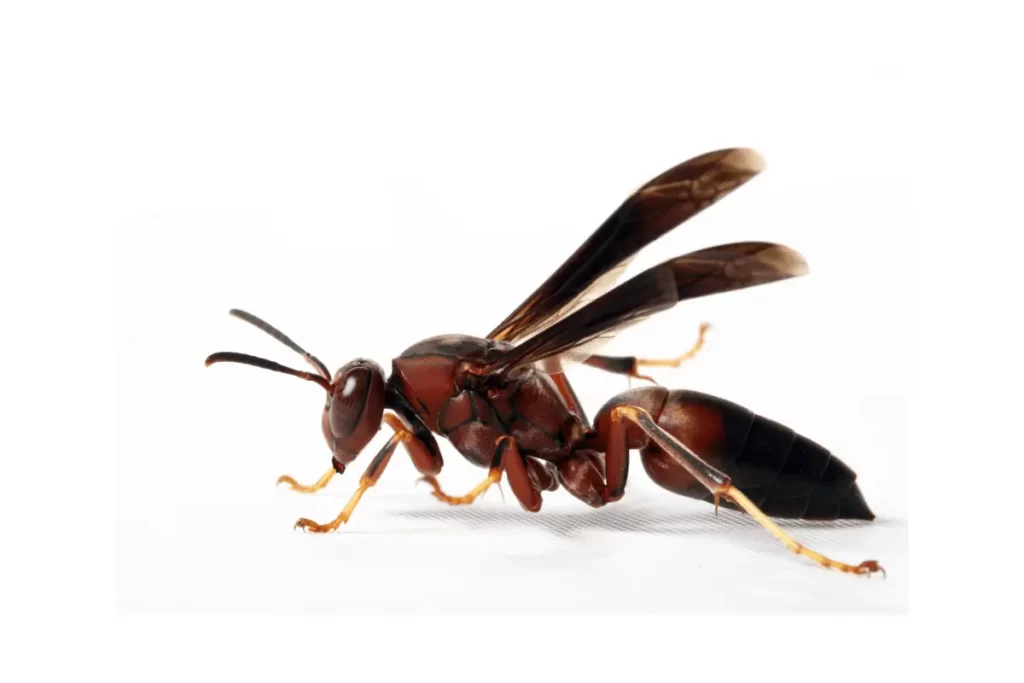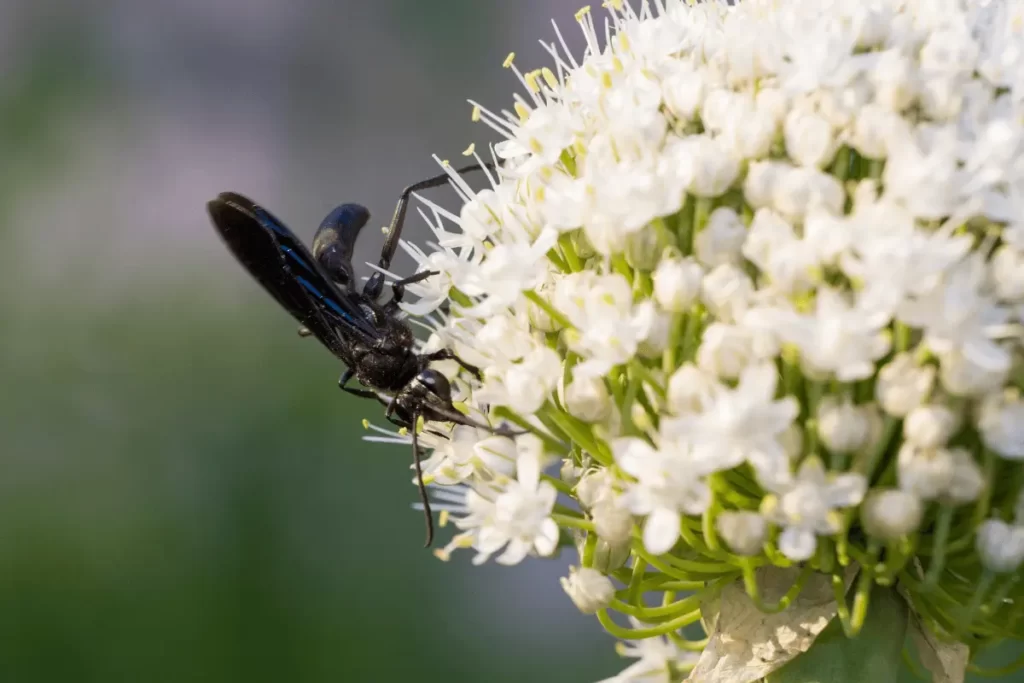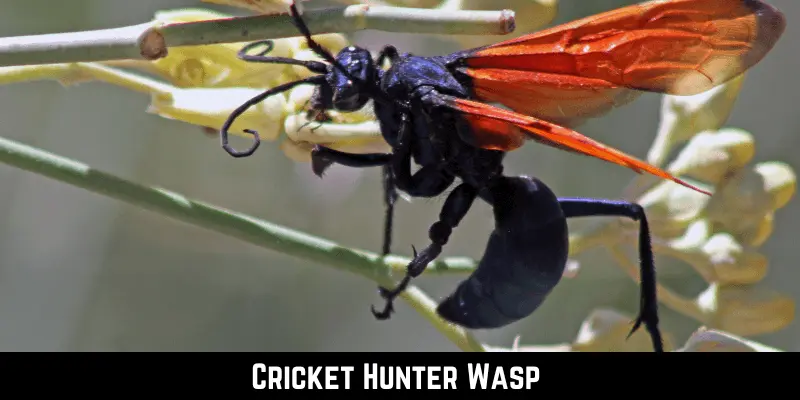When you hear the word “cricket,” you might think of the sport or the chirping sound on summer nights. But for the Cricket Hunter Wasp, crickets mean something different. Have you ever heard of this special wasp “cricket hunter wasp”?
The Cricket Hunter Wasp, also known by its fancy name, Sphecius speciosus, has a very interesting life. It hunts crickets, but not for eating right away. Instead, the female wasps use the crickets in a special way to help their babies grow.
If you enjoy discovering nature’s secrets or just love interesting facts, keep reading! Let’s explore the amazing world of the Cricket Hunter Wasp.
Physical Characteristics
Size and Coloration
The Cricket Hunter Wasp is a unique insect known for its special size and bright colors. This wasp is different from other insects because it shows the changes it has gone through over a long time.

Most of these wasps are about half an inch to one and a half inches long. This site helps them live in many different places, from big fields to small gardens. Their main body color is mostly dark blue or shiny black. Their bodies can sparkle like blue gems on the ground when the sun shines. Their legs have colors that stand out, usually amber or bright orange. These colorful legs are not just for walking but can also help them attract mates or tell other animals to stay away.
Wing and Body Structure
The Cricket Hunter Wasp has wings that are perfectly made for flying. These wings are thin and clear, looking a bit like the colored windows in old churches. But even though they look delicate, they are strong and help the wasp catch its favorite food, crickets.
The wasp’s body comprises three main parts:
- The head,
- The middle part (thorax),
- And the lower part (abdomen).
Each part has its special job. The middle part has a lot of muscles and helps the wasp fly quickly. The lower part is where many important body parts are, and it also has a sharp stinger that the wasp uses for protection and hunting. With its strong body and quick wings, the Cricket Hunter Wasp can move around very gracefully. It’s like watching a dancer perform, moving smoothly and beautifully in nature.
Habitat and Distribution
Regions of Predominance
On our big Earth, the Cricket Hunter Wasp is a real traveler. This bug lives in many different places, from hot to cold. It doesn’t only stay in one area but has made homes in both common and surprising places.
This wasp’s journey shows how strong and flexible it is. They live in the warm places of Africa and the grassy areas of North America. A long time ago, when there were land bridges between continents, these bugs used them to go to new places. It’s like they went on big adventures that even famous travelers would be impressed by! In the south of Europe, you can see them around olive trees and grape farms, enjoying the sunny weather. In Asia, they move around bamboo forests and tea farms, even near big mountains.
Preferred Habitats
Looking at where the Cricket Hunter Wasp likes to live is like opening a door to an artist’s special room. Each place tells a story of its love for life and nature. They pick places that are safe and have lots of food.

They like grassy fields. In these fields, with lots of grass and flowers, the wasps find the best places to live and find food. The soft ground is perfect for them to dig and make their homes, and there are many crickets for their babies to eat.
Many of them also like gardens that people make. These gardens have different plants and lots of crickets for them to catch. They also live near the edges of the woods, especially where there are open spaces with sunlight. This kind of place is warm and good for their babies. The type of ground is very important for these wasps. They look for places where the soil is soft, so they can easily dig and make their homes. It’s like how artists pick the best materials for their work.
Behavior and Lifecycle
Hunting Techniques
In nature, the Cricket Hunter Wasp is like a smart hunter with special skills. Watching it hunt is like seeing a great warrior from old stories in action.
The most important thing for the Cricket Hunter Wasp when hunting is patience. Like a warrior planning a strategy, the wasp watches and waits for the right time. When a cricket, which can be bigger than the wasp, comes close, the wasp quickly flies down and uses its special venom to make the cricket unable to move but still alive. This way, the cricket stays fresh for the wasp’s babies to eat later.
Reproduction and Lifespan
Cricket Hunter Wasps have a unique and important life cycle.
- The female wasp lays her egg on a paralyzed cricket, which she places in a burrow.
- As the egg hatches, the baby wasp (larva) has a ready meal: the cricket.
- The larva eats and grows over several days.
- It then changes from larva to a cocoon-like stage (pupa) and finally into an adult wasp.
- Adult Cricket Hunter Wasps live for a short time, often just a few weeks.
- In this short life, their main goal is to find a partner and start the cycle again.
- Even though their life is brief, it’s important for nature.
- They play a key role in the balance of the ecosystem by controlling cricket populations.
Watching their life cycle shows the balance of life, growth, and nature’s way of ensuring life continues.
Cricket Hunter Wasps’ Relationship with Crickets
How Waps Capture Crickets?
In nature’s big picture, the way the Cricket Hunter Wasp hunts its main food, the cricket, is really smart and skillful. It’s like watching a well-planned dance where every step counts.
- Watching Before Acting: The wasp doesn’t just dive in. It stays still and watches the cricket carefully, like someone trying to sneak up on someone else without being noticed.
- Fast Flight: When it’s time to act, the wasp flies quickly toward the cricket, like an arrow speeds out when shot from a bow.
- Using Venom: The wasp uses a special poison instead of hurting the cricket. This poison makes the cricket unable to move but keeps it alive, which means it remains fresh food.
- Carrying the Cricket: After that, the wasp does something amazing. It carries the cricket, which is often much heavier, over different types of ground to a special hole it has dug. It’s like seeing someone do a super strong action you’d hear in old stories.
- Safe Storage: Inside this hole, the wasp puts the cricket in a special room. This isn’t just a place to keep food; it’s where the wasp will lay its egg, and the baby wasp will have its first meal.
Significance of Crickets in Wasp’s Diet
The Cricket Hunter Wasp doesn’t just eat crickets because they taste good. Crickets play a super important role in the wasp’s life, from helping baby wasps grow to keeping nature balanced.
- Super Food: Crickets are like a power meal. They’re packed with proteins, fats, and other nutrients. Baby wasps, called larvae, eat these crickets to grow big and strong.
- Fresh Meal Strategy: Instead of killing the cricket, the wasp paralyzes it. It may seem creepy, but it’s a smart move. This way, the cricket stays fresh, so when the baby wasp is ready to eat, its food hasn’t gone bad. It’s like keeping food in the fridge for later.
- Helping Nature Stay Balanced: Crickets aren’t just food for wasps. They are part of nature’s system. By hunting crickets, the wasps stop them from eating too many plants. So, wasps help gardens and other places from being overrun by too many crickets.
Wasp’s Interactions With Humans
Benefits of Gardens and Farms
They Control Pests Naturally:
- As their name suggests, Cricket Hunter Wasps love eating crickets.
- They help keep cricket numbers in control. This is great because too many crickets can harm plants in gardens and farms.
They Help with Pollination:
- Even though they aren’t mainly there to pollinate, they do it by accident. When they visit flowers for nectar or fly around, they help flowers make seeds.
- This accidental pollination can make gardens bloom better, and farms produce more food.
They Add to Nature’s Variety:
- Having these wasps around means having a more varied and lively garden or farm. A place with many different plants and animals is usually healthy.
- When these wasps are around, they can attract other helpful bugs and even birds. This creates a well-balanced environment.
They Help the Soil Breathe:
- These wasps dig in the ground to make homes for their babies and food. When they dig, they let air into the soil.
- This digging can make the soil healthier. It helps plant roots grow better and lets water soak into the ground more easily.
Potential Threat or Harm Of Wasps to Humans
They Can Sting, but Usually Don’t:
- Like many wasps, Cricket Hunter Wasps have stingers, mainly used for catching crickets.
- They don’t usually bother people. But if they feel trapped or scared, they might sting, just like someone might use an umbrella to protect themselves when it suddenly rains.
Some People Might Be Allergic:
- If they do sting, some people might get allergic reactions. This can be a small skin rash or something more serious for a few.
- If you know you’re allergic to stings and get stung. It’s important to get medical help quickly.
They Don’t Want to Bother Humans:
- Sometimes, we might think they’re harmful because they’re near us, but they’re not out to get us.
- It helps to know more about them. We can be less scared when we understand they’re mostly after crickets.
Sometimes They Dig in the Wrong Places:
- Now and then, they might dig homes in places we wish they wouldn’t, like in pretty gardens or kids’ play zones.
- While this is good for nature, we might need to show them better spots to dig sometimes.
Damage As Pest
Cricket Hunter Wasps are insects that might sound scary, but they’re not harmful to us. They come from the Sphecidae family and have a unique way of life that involves hunting crickets. They don’t damage our farms or eat our food.
However, some people might notice these wasps because of the way they make their homes. They like to dig in the soil or sand and move small plants around. This digging can be a problem for people who love their gardens. But these wasps are good for nature! They keep the number of crickets in check, which helps many plants grow better.
Conservation Status
When we study insects, we see that each one has a special job in nature. The Cricket Hunter Wasp is a lone insect, so it doesn’t gather in big groups or grow in numbers quickly. Because of this, people often forget about it when discussing protecting insects.
There aren’t many worries about these wasps disappearing. But, like all insects, things like losing their homes, harmful chemicals, and weather changes can affect them. It’s important to remember that every insect has a role in nature. We should protect all of them to keep the balance of nature going strong.
Cricket Hunter Wasp Sting
Cricket Hunter Wasps have wings that look very delicate, but they also have a sting. They use this sting mainly for hunting crickets. It’s usually because they’re trying to defend themselves if they sting humans. They don’t just sting for no reason, unlike some other wasps.
If you get stung by one, it feels sharp, but it goes away quickly. It doesn’t hurt as much as a bee sting or the sting from bigger wasps. Still, everyone is different. Some people might feel it’s just a tiny pinch, but others might have a stronger reaction and need to see a doctor. It’s a way of the wasp telling us they want their space to live and hunt.
Cricket Hunter Wasp Sting Pain Index
Not all insect stings feel the same. Dr. Justin O. Schmidt, a bug expert, made a list called the Schmidt Pain Index that talks about how painful different stings are. The Cricket Hunter Wasp’s sting isn’t the most painful one on this list.
Some people say the sting feels like a quick poke from a needle. Others say it burns but only for a short time. There are more painful stings, like from the bullet ant or the tarantula hawk. Compared to those, the Cricket Hunter Wasp’s sting is less painful but can still make you react. It’s like a small voice in a loud room – you can hear it, but it doesn’t last long.
Cricket Hunter Wasp Nest
Cricket Hunter Wasps might not build huge homes like bees or ants, but how they create their nests is interesting. These wasps like to live alone, and each female wasp is an expert at making burrows. They dig these burrows in sandy or soft soil. Why? To provide a home for their baby wasps.
But here’s where it gets exciting: After digging, the wasp will find a cricket and paralyze it. She then brings this cricket into the burrow. This cricket becomes food for the baby wasp when it’s born. From digging a home to finding food, these wasps show us how amazing nature can be. Their nests may look simple from the top, but underneath, they tell a story of hunting, living, and starting anew.
Cricket Hunter Wasp Sting Treatment
Even though Cricket Hunter Wasps usually don’t bother humans, sometimes they might sting if they feel threatened. Everyone reacts differently to insect stings. Some might feel a quick burning pain, while others might feel a longer-lasting ache.
If you get stung, here’s what you should do:
- Wash the sting area with soap and water. This helps prevent any infections.
- Put something cold, like an ice pack, on the sting. This will help with pain and swelling.
- Consider taking medicine from the store, like painkillers or antihistamines. They can help with the pain and any allergic reactions.
But always watch out for serious reactions. Some people are very allergic to insect stings. If you have trouble breathing, your heart is beating very fast, or the sting area swells a lot, you should get medical help immediately.
We can better understand and respect the natural world by learning about creatures like the Cricket Hunter Wasp. It’s filled with incredible creatures, big and small, each playing its special role.
How To Get Rid Of Cricket Hunter Wasp?
Before taking action, remember that these wasps are good for controlling crickets in gardens. Seeing them can mean your garden is alive and thriving.
Finding Their Homes
Keep an eye out for tiny hills of soil or holes in soft or sandy areas. Unlike big wasp nests, these are small, single holes.
Using Natural Ways to Keep Them Away
- Plants: Planting marigolds, wormwood, eucalyptus, and citronella can help. These plants are known to keep wasps away.
- Essential Oils: Strong-smelling oils like peppermint, eucalyptus, or tea tree can be spread near their homes. Wasps usually don’t like these smells.
Making Their Homes Less Welcoming
- Change the Soil: If you know where they like to build homes, try making that ground harder or putting mulch on it. They like sandy or soft ground, so changing it can keep them away.
- Using Water: You can pour water into their homes early in the morning or late in the evening when the wasp rests. Remember not to waste too much water and be careful not to hurt other good bugs.
- Diatomaceous Earth: This natural insect killer can be sprinkled around their homes. It’s safe for people and pets but not for insects.
Getting Help from Other Animals
Having birds in your garden is lovely; they can eat many bugs, including wasps.
Moving the Wasps Safely
If you don’t have too many wasps, think about moving them. Using a glass and a card, you can gently trap them and move them to a far-away place with many trees.
When to Call Experts
If you’ve tried many things and still have too many wasps, or if you see more and more of them, it might be time to call experts who know how to handle bugs.
Stopping Them Before They Start
Taking care of your garden can stop wasps from coming. Check for too many crickets, mix up the soil occasionally, and clean up any mess. This can make it harder for wasps to make a home.
Other Wasp Types Found in The USA
We have written detailed guidelines about other types of wasps found in the USA. You can find everything about these species here:
Conclusion
Nature is like a big storybook; Cricket Hunter Wasps are important characters. Even though some people might be scared of them because they can sting, these wasps do many good things for our environment. They help control the number of crickets and make the soil better when digging their homes.
Sometimes, people might not like the holes they make in the ground, but we should remember the good things they do for nature. If we see lots of these wasps, it’s a sign that our environment is healthy.
People often think these wasps might be dangerous because they can sting. But the truth is, they mostly use their sting to catch crickets. They are not interested in bothering people; they just want to live their lives, find food, and take care of their babies.

